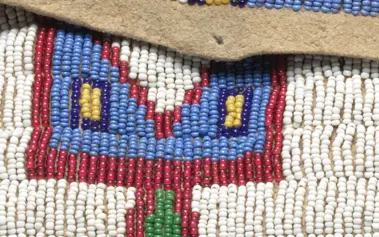In a landscape rich with cultural heritage, South Dakota stands as a testament to the vibrant Indigenous communities that have long called the region home. This story, penned by journalist Amelia Schafer, takes a deep dive into the world of Indigenous beadwork, a significant cultural expression, while examining its ties to identity and representation.
As part of her ongoing series with ICT, Schafer discusses the complex issues surrounding Indigenous identity, a narrative she is intimately familiar with. Her journey into journalism, which began with an impactful internship in Iowa Falls, Iowa, has brought her to South Dakota, a state renowned for its Indigenous history and artistry.
During a recent appearance on the October 22 ABC Live morning newscast, Schafer chose to wear a pair of striking beaded earrings acquired from the Black Hills Powwow, an event celebrated for showcasing some of the finest Native American art and dance.

Lakota Beadwork
The earrings, handcrafted by a Native artist, sparked a lively debate online, with over 100 individuals from Indian Country coming to Schafer’s defense when a viewer admitted they were too distracted by the earrings to focus on the broadcast. This incident underscores both the cultural significance of beadwork and the ongoing challenge of Indigenous visibility in media.
South Dakota, home to several prominent Indigenous tribes like the Lakota, Dakota, and Nakota, is a state where traditional crafts like beadwork are not merely artistic endeavors but vital cultural practices. For Schafer, who is of Wampanoag and Brothertown descent, beadwork became a conduit to explore her mixed Native heritage, starting with her first pair of beaded earrings purchased in 2019.
Her growing interest in beadwork led her to Chicago’s American Indian Center, where she honed her skills and connected with others passionate about preserving their cultural heritage. This nurturing environment allowed Schafer to delve deeper into her own identity, engaging with a practice that not only connected her to her ancestors but also offered a way to express and celebrate her heritage.
One of the most poignant moments in Schafer’s journey was discovering a beaded purse originating from her Brothertown ancestors at the Smithsonian’s National Museum of the American Indian. The purse, a testament to resilience and survival, inspired Schafer to replicate it using traditional raised beadwork techniques, now housed at the Brothertown museum in Fond Du Lac, Wisconsin.
This replication not only honored her ancestral artisans but also served as a personal exploration into the history and cultural practices that influence her identity. “It was almost like the memories came flowing through me,” Schafer reflects, emphasizing how engaging in such traditional crafts allows her to partake in a legacy challenged by centuries of assimilation and relocation.
South Dakota itself is a state where history and modernity intertwine, with Indigenous culture playing an integral role in shaping its identity. Events like the Black Hills Powwow not only celebrate these vibrant traditions but also educate broader audiences on the intricate artistry and cultural narratives embedded in crafts like beadwork.
Schafer’s story is a reminder of the importance of representation in media, especially for Native communities rarely depicted in mainstream narratives. Her experience as a ‘White Native’ underscores the privilege that comes with being more digestible to non-Native audiences while highlighting the need for diverse voices in journalism.
The significance of beadwork in Indigenous culture, particularly within South Dakota’s rich landscape, cannot be overstated. It is a celebration of resilience, identity, and artistry. Schafer’s narrative encourages everyone, especially during Native American Heritage Month, to embrace their culture and proudly showcase such expressions of identity.
In Schafer’s words, “Always wear the big auntie earrings, and don’t let anyone tell you not to.” This statement resonates with those who seek to understand and express their Indigenous identity through the lens of tradition and modern-day representation.